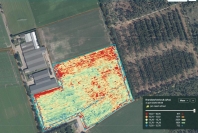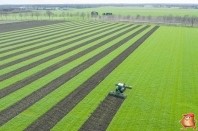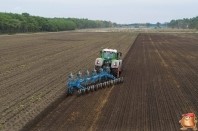Step 5: Tillage
Before soil cultivation is started, the order in which the plots can be optimally processed is determined on the basis of the soil scan. When a tool is controlled manually, there is always unnecessary overlap. So there are places on the plot that have been worked twice. A double operation ensures extra wear on machines, extra fuel consumption, extra labor costs and other unnecessary costs. By using GPS, the overlap, and therefore unnecessary costs, is reduced to a minimum. For example, all tractors at Van den Borne are equipped with an RTK-GPS system. RTK-GPS is an autopilot system that can fully control a tractor or implement by means of GPS signals via the mobile network. The normal steering system of the tractor is interrupted because a hydraulic valve is placed in between. This hydraulic valve is controlled by the computer of the RTK-GPS system. Straight lines or contours can be set on the control panel that is linked to the computer. These lines repeat each working width again in order to achieve a minimal overlap. Minimal overlap saves fuel, time and wear of the machines. The photos below show how GPS works straight and without overlapping at our company. In addition, automatic control allows day and night work with high precision. The accuracy of RTK-GPS is between 2 to 5 cm depending on the type of GPS signal that can be received. The RTK-GPS system is used during tillage, planting and sowing, spraying, fertilizing and harvesting.
The diesel consumption of the tractor is saved during tillage operations. This happens in all tillage operations such as during plowing, milling, spading and cultivation and is used to map the soil compaction. This can then be used to improve the soil in the following years. This also allows the costs of an operation to be calculated. Below is an example of a diesel consumption card.






















Social media
Bezoekers online: 61